|
The Surf Ballroom
Clear Lake, Cerro Gordo County, Iowa

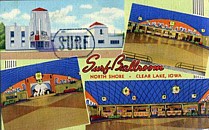 Long before the world cast its attention to a cornfield five miles north of Clear Lake,
the 'night the music died,' there was the Surf Ballroom. Later it would be referred to as 'the old Surf.'
This building was the original Surf Ballroom, located on the shore at Witke's Beach.
Long before the world cast its attention to a cornfield five miles north of Clear Lake,
the 'night the music died,' there was the Surf Ballroom. Later it would be referred to as 'the old Surf.'
This building was the original Surf Ballroom, located on the shore at Witke's Beach.
Carl Fox, one of Clear Lake's most visionary businessmen,
was instrumental in establishing one of the Midwest's most enduring and beloved venue for dancing and big band entertainment.
The original Surf Ballroom was built on the former site of Petersen's Bath House and subsequently the Tom Tom Emporium. The
new building was of a deco style which defined Clear Lake's secondary commercial district. It was an open space roofed
with curved trusses which gave the street facade a highly identifiable feature, punctuated by two obelisk-like towers.
The Surf Ballroom, a wooden framed structure, was built in 1933, named from the desire of the Carl Fox to create
a ballroom that resembled an ocean beach club. Furnished with bamboo and rattan items, the murals on the back walls
were hand-painted to depict pounding surf, palm trees swaying in a gentle breeze, sailboats and lighthouses. The stage
was surrounded by palm trees and clouds were painted overhead.
Extending beyond the main entry was Decker's Hamburger Stand, directly connected structurally but separate in function from the ballroom. The roof over this section
was used as an open-air roof garden, providing space for dining.
The Surf was quite popular and became known nationally with entertainers such as Count Basie, Duke Ellington, Glenn Miller, Stan Kenton, Tommy Dorsey and Jimmy Dorsey making regular appearances.
By the mid-1930's, Decker's Hamburger Stand was phased out. Major renovations
added later included a theater marquee and display cases which were on either side of the entry doors.
The Clear Lake Mirror Reporter
Clear Lake, Iowa, May 16, 2007
Remember When
The Surf Ballroom was completely destroyed by fire which broke out at 2:30 am Sunday [April 20th]. The building was in
flames when firemen arrived on the scene. Carl Fox and his family, asleep in an upstairs apartment when the fire broke out, were
able to escape. Mason City firemen were called here to aid in fighting the blaze.
NOTE: The Surf was gutted by the fire with damage so extensive that restoration would not be a reasonable option.
The New Surf Ballroom
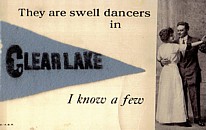 The Clear Lake community and dancers throughout the Midwest got behind the ownership of the Surf Ballroom and it was
rebuilt in 1948 across the street [460 North Shore Drive] from its
original location. Drawn by appearances of internationally known performers, The Surf was often filled to capacity,
which is 2,100 with 30,000 square feet of entertainment area that includes a 6,300 square foot wooden dance floor. The Clear Lake community and dancers throughout the Midwest got behind the ownership of the Surf Ballroom and it was
rebuilt in 1948 across the street [460 North Shore Drive] from its
original location. Drawn by appearances of internationally known performers, The Surf was often filled to capacity,
which is 2,100 with 30,000 square feet of entertainment area that includes a 6,300 square foot wooden dance floor.
The Tom Owens Cowboys often would play the Midwest ballroom circuit 90 nights in a
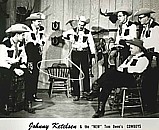 row, seven nights per week while
playing on a daily radio show. The "Cowboys" weekly television show on WMT-TV was one of the pioneer programs in
eastern Iowa. Their amazing number of performances - nearly 750 a year - will never be equaled within the music
industry.
row, seven nights per week while
playing on a daily radio show. The "Cowboys" weekly television show on WMT-TV was one of the pioneer programs in
eastern Iowa. Their amazing number of performances - nearly 750 a year - will never be equaled within the music
industry.
Tom Owens passed away in 1955. The band continued on under the name of "Johnny Ketelsen and the New
Tom Owens Cowboys." Eventually, they were known as the "Johnny Ketelsen Band."
Johnny played guitar, banjo,
upright bass, and was a featured singer. He also tried his hand at spinning the rope.
He was inducted into the Nebraska Country Music Hall of Fame in 2007.
Keith Crawford played the trumpet; Von Crawford played the clarinet and saxophone; Duane Stepanek played bass and
steel guitar; Chuck Wakeland played the accordion, and, Mibs Allen rounded out the band, playing drums.
An ongoing tradition at The Surf is for the bands to autograph the walls
backstage prior to their concert.
Carroll D. Anderson (1919-2006) managed the Surf during the 1950's - the dawning era of rock and roll. Quick to book the
hottest names in the business, Anderson booked a Winter Dance Party concert to be held on February 2, 1959.
Winter Dance Party
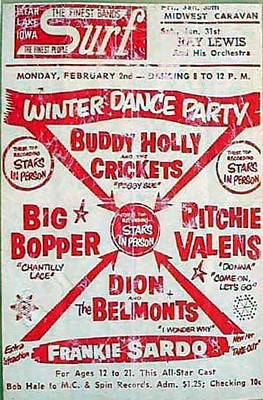 "The Winter Dance Party" was an infamous 24-day tour of the Midwestern United States with the hottest rock
and roll stars of the day - Buddy Holly and the Crickets, Dion and the
Belmonts, Ritchie Valens, and the
J. P. "The Big Bopper" Richardson. Scanned copy of original Winter Dance Party poster at right.
"The Winter Dance Party" was an infamous 24-day tour of the Midwestern United States with the hottest rock
and roll stars of the day - Buddy Holly and the Crickets, Dion and the
Belmonts, Ritchie Valens, and the
J. P. "The Big Bopper" Richardson. Scanned copy of original Winter Dance Party poster at right.
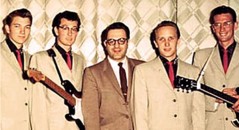 Charles Hardin "Buddy" Holly was born in Lubbock, Texas on September 7, 1936, the fourth of four children born to
Lawrence and Ella Holly. In Texas during those days almost everyone had a nickname and the family always called the youngest
child of the family "Buddy." The HollyS had a rich musical tradition with older brothers Larry and Travis teaching
themselves how to play the guitar and sister Pat singing duets with Mrs. Holly during the evening at the piano in the
living room. The Hollys attended services at the Baptist Church, singing praises of joy to God.
Charles Hardin "Buddy" Holly was born in Lubbock, Texas on September 7, 1936, the fourth of four children born to
Lawrence and Ella Holly. In Texas during those days almost everyone had a nickname and the family always called the youngest
child of the family "Buddy." The HollyS had a rich musical tradition with older brothers Larry and Travis teaching
themselves how to play the guitar and sister Pat singing duets with Mrs. Holly during the evening at the piano in the
living room. The Hollys attended services at the Baptist Church, singing praises of joy to God.
At the age of five, Buddy won five dollars singing "Down the River of Memories." He began taking
piano lessons at the age of eleven but soon switched over to the steel guitar. Twenty lessons later he switched to an
acoustic guitar. Buddy didn't have much of a formal musical education but he was familiar with many kinds of music,
his ear tuned to the blues and country music playing from the radio.
In 1951 Buddy met Bob Montgomery, a fellow seventh-grader
at Hutchinson Junior High. Bob also played the guitar and sang country songs. His taste in music would be a major influence
in Buddy's choice of music. Billing themselves as "Buddy and Bob," they played at junior high assemblies and were often
invited to play on local radio shows. Larry Wellborn soon joined them, playing bass.
During high school, Buddy played in a
country-oriented Western and Bop Band, performing at local clubs and high school talent shows. Bob usually sang lead during
this time. Buddy and Bob widened their audience, appearing at Union Hall in Carlsbad, New Mexico,
The Clover Club at Amarillo, Texas, and Lubbock's Cotton Club and The Bamboo Club. Although Bob was the principal composer, Buddy began to write
songs. Two of his songs were "Heartbeat" and "Love's Made a Fool of You" which he recorded several years later. Jerry Allison joined Bob and
Buddy, playing the drums.
Lubbock's radio station KDAV aired the "Sunday Party" which often used a "western and bop" duo to open the program. On
October 14, 1955, Bill Haley and the Comets starred in a show at the Fair Park Auditorium with Jimmie Rodgers, Hank Snow,
and "Lubbock's own Buddy, Bob, and Larry." The show's promoter, Eddie Crandall was so impressed with Buddy's performance
that he told Holly sadie he would attempt to get them a recording contract. Buddy was offered a contract from Decca Records in
January of 1956. The only problem was that the contract was offered to just Buddy. Urged by Montgomery, Buddy cut his record
and then returned to Lubbock. On June 3, 1955, Buddy and Bob opened a concert for a young and upcoming Elvis Presley at
Connelly's Pontiac Showroom, a free show intended to attract customers.
Signing a contract with Decca Records, their first
recording session was in Nashville on January 26, 1956. The records, which included "That'll Be the Day," went nowhere.
During this time Holly wrote the song "Cindy Lou." Renamed "Peggy Sue" at the suggestion of band member Jerry Allison,
it would later be one of Holly'S biggest hits.
Holly and the newly named Crickets recorded the rock version of "That'll
Be the Day" on February 25, 1957. Decca released the song in June of 1957 as sung by "The Crickets." Sales were slow at
first. However by September it was one of the best-selling records in both the rock and roll and R&B markets.
During the next year, either Buddy as a soloist or Buddy and the Crickets cut a hit
record every other month. During this time they began touring extensively with the Alan Freed shows and made their television
debut on The Ed Sullivan Show.
Holly split from manager Norm Petty over a failure to account properly for the
group's earnings. Holly was changing to a lighter style of rock and roll. The other Crickets didn't like that direction.
They eventually split up with the Crickets staying in Lubbock and Holly moving to Greenwich Village, New York, where he married Maria
Elena Santiago.
The split from Petty caused legal problems for Holly and tied up his money. In a situation where he needed to
tour so he could pay the bills, Holly put together a backup group consisting of Tommy Allsup, Waylon Jennings, and Charlie
Bunch. Early in 1959, Buddy Holly and the Crickets joined The Winter Dance Tour Party of the Midwest.
Dion DiMucci was born in the Bronx on July 18, 1939, the son of a professional puppeteer. Dion began singing at the age
of five and few years later picked up a guitar. His father introduced him to Paul Whitman, a 1920's bandleader who was
best known for discovering and promoting young talent. Around the age of twelve, Dion began appearing with Whitman on
radio and televisions shows, including Whitman's own Teen Club. When he wasn't performing, Dion was
singing with The Fordham Daggers or singing on street corners.
Early in 1957, Dion booked some studio time and recorded
four rock and roll songs as a Valentine's Day present for his mother. The producers of the Teen Club television show
out of Philadelphia heard the demo and promoted it.
When approached by Irv Spicer of Mohawk Records, Dion said he'd
record a single but only if he could use his own back-up group. Spicer agreed. Dion found the best street singers he knew -
Carlo Mastrangelo, Freddy Millano and Angelo D'Aleo - who became the Belmonts, named after Belmont Avenue. Appearing on
Dick Clark's Saturday night program in May of 1958, there was no turning back for Dion and the Belmonts. Their big break-out
hit came in the spring of 1959, "A Teenager in Love."
Dion and the Belmonts joined the Winter Dance Party tour of 1959.
After the concert at the Surf Ballroom
on February 2, 1959, Dion passed up a plane ride, opting to ride the bus to the next gig in Moorhead, Minnesota.
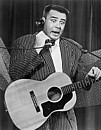 Jiles Perry "J. P." "The Big Bopper" Richardson was born October 24, 1930 at Sabine Pass, Texas, the oldest son of
Jiles Perry Sr., an oil field worker and driller, and Elsie (Stalsby) Richardson. The family moved to Beaumont, Texas,
where J. P. played on the "Royal Purple" football team as a defensive lineman wearing the number 85. He graduated from
Beaumont High in 1947 and entered into pre-law school at Lamar College. Richardson was a member of the band and chorus,
some times playing with the Johnny Lampson Combo.
Jiles Perry "J. P." "The Big Bopper" Richardson was born October 24, 1930 at Sabine Pass, Texas, the oldest son of
Jiles Perry Sr., an oil field worker and driller, and Elsie (Stalsby) Richardson. The family moved to Beaumont, Texas,
where J. P. played on the "Royal Purple" football team as a defensive lineman wearing the number 85. He graduated from
Beaumont High in 1947 and entered into pre-law school at Lamar College. Richardson was a member of the band and chorus,
some times playing with the Johnny Lampson Combo.
Richardson worked part-time at the Beaumont radio station KTRM [now
KZZB] and quit college upon being hired full-time in 1949. He was promoted to Supervisor of Announcers at KTRM.
He married Adrianne Joy Fryou on April 18, 1952, and a daughter, Debra Joy, was born to the couple in December of 1953.
Richardson was drafted into the U.S. Army in March of 1955, doing his basic training at Fort Ord in California. He served
two years as a radar instructor at Fort Bliss near El Paso, Texas, and was discharged with the rank of Corporal in March
of 1957.
Returning to KTRM, Richardson held down the "Dishwashers' Serenade" shift from 11 a.m. to 12:30 p.m. Monday
through Friday. Upon being asked to fill a new time slot, Richardson suggested an idea for the show. He had seen college
students doing a dance called "The Bop" and decided to rename himself "The Big Bopper" for his new show which ran from
3 to 6 p.m. Soon he was the station's program director.
He broke the record for continuous on-the-air broadcasting with a remote
set-up in the lobby of the Jefferson Theatre in downtown Beaumont, performing for a total of five days, two hours,
and eight minutes during which time he played 1,821 records. He showered during five-minute newscasts. Richardson is
also credited with coining the term "music video" in 1959, and recorded an early example himself.
Richardson played guitar and began his musical career as a song writer. His song "White Lightning" was later recorded by
George Jones and was Jones' first #1 country hit in 1959. Inspired by a childhood memory of the Sabine River where
he had heard stories about Indian tribes, Richardson wrote "Running Bear" for his friend Johnny Preston. Richardson sang background
on "Running Bear" which was released after his death. Within months of its release, "Running Bear" soared to number one on the charts.
Harold "Pappy" Daily from Houston, Texas, signed Richardson to Mercury Records. Richardson's first single, "Beggar To A King" failed to
gain any action on the charts. Upon cutting "Chantilly Lace" as "The Big Bopper" for Daily's D label, the song climbed the charts
during the summer of 1958, reaching #6 and was in the Top 40 national hits for 22 weeks.
RICHARSON'S big voice and
exuberant personality launched him in the limelight as an early rock and roll star.
Enjoying the success of "Chantilly Lace," Richardson took some time off from KTRM radio to join Buddy Holly, Ritchie
Valens, and Dion and the Belmonts on the "Winter Dance Party" tour of 1959.

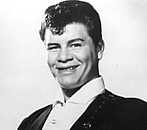 Richard Steven "Ritchie" Valens was born in County Osteopathic Hospital, San Fernando, California (north of Los
Angeles) on May 13, 1941. He was the youngest son of Concepcion "Connie" Valenzuela and Joseph Steven "Steve" Valenzuela, a tree surgeon by trade who also dabbled
in mining operations and trained horses. When Ritchie was born, Connie and Steve
were working in a munitions plant located in Saugus, north of the San Fernando Valley. Connie had a four-year-old son,
Robert MORALES, from a previous marriage when Ritchie was born. The Valenzuela family lived in San Fernando until Connie
and Steve divorced in 1944. Steven died of diabetes in 1951. Connie, with her son Robert and two young daughters Connie
and Irma, moved into the house on Filmore Street in Pacoima. Because the house was tiny Ritchie lived with various aunts and uncles
in various towns in the upper Los Angeles area. He spent a great deal of time with his Aunt Ernestine and Uncle Lelo Reyes.
Richard Steven "Ritchie" Valens was born in County Osteopathic Hospital, San Fernando, California (north of Los
Angeles) on May 13, 1941. He was the youngest son of Concepcion "Connie" Valenzuela and Joseph Steven "Steve" Valenzuela, a tree surgeon by trade who also dabbled
in mining operations and trained horses. When Ritchie was born, Connie and Steve
were working in a munitions plant located in Saugus, north of the San Fernando Valley. Connie had a four-year-old son,
Robert MORALES, from a previous marriage when Ritchie was born. The Valenzuela family lived in San Fernando until Connie
and Steve divorced in 1944. Steven died of diabetes in 1951. Connie, with her son Robert and two young daughters Connie
and Irma, moved into the house on Filmore Street in Pacoima. Because the house was tiny Ritchie lived with various aunts and uncles
in various towns in the upper Los Angeles area. He spent a great deal of time with his Aunt Ernestine and Uncle Lelo Reyes.
Music was a guiding force in young Ritchie's life. Although he was influenced by Mexican folk songs and popular songs, his
true devotion was with the singing cowboy of Saturday matinee movies. At the age of eleven, his relatives began teaching him
how to play the guitar. Ritchie brought his guitar with him everywhere he went. During lunchtime at Pacoima Junior High School,
he would sit on the bleachers and either practice or entertain his friends with his music. He appeared in school variety
programs. For his shop project, at the age of thirteen Ritchie made an electric guitar out of scrap lumber and electrical parts.
By the time he entered San Fernando High School, Ritchie was playing the guitar for school assemblies and after school
parties. During his junior year, he joined the Silhouettes, the only rock and roll band in the area. They were playing
at an American Legion Hall in January of 1958 when they were taped by a part-time talent scout working for Bob Keane,
owner of Keane Records. Keane wanted to hear more.
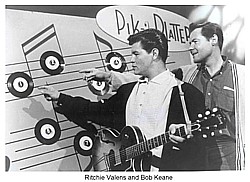 Ritchie auditioned for Keane in May of 1958 in Los Angeles. At the
time Keane Records was enjoying a string of hits recorded by Sam Cooke but was looking for new talent for their new label,
Del-Fi Records. Ritchie's audition went well. Keane set up a formal recording session. Ritchie played an instrumental number
which was recorded 'as is' with Keane asking Ritchie to make up his lyrics as he went along. The result was "Come On, Let's
Go" which was an instant hit in the Los Angeles area early in the summer of 1958. Ritchie's name was shortened to "Valens."
In August, "Come On, Let's Go" was released nationally and sold a half-million copies.
Ritchie auditioned for Keane in May of 1958 in Los Angeles. At the
time Keane Records was enjoying a string of hits recorded by Sam Cooke but was looking for new talent for their new label,
Del-Fi Records. Ritchie's audition went well. Keane set up a formal recording session. Ritchie played an instrumental number
which was recorded 'as is' with Keane asking Ritchie to make up his lyrics as he went along. The result was "Come On, Let's
Go" which was an instant hit in the Los Angeles area early in the summer of 1958. Ritchie's name was shortened to "Valens."
In August, "Come On, Let's Go" was released nationally and sold a half-million copies.
After a short tour,
Ritchie recorded "Donna," a ballad he had written for his high school sweetheart, Donna Ludwig. The flip side was "La Bamba,"
a reworked traditional Mexican folk song of the same name.
Ritchie was very busy with appearances and recording sessions.
He appeared in a cameo role in the movie "Go, Johnny Go!" and on Dick Clark's American Bandstand program on December 27th.
When Ritchie
joined the Winter Dance Party on January 23, 1959, his singles "Donna" and "La Bamba" were moving toward the top Ten,
making him the most popular artist on the tour at the time.
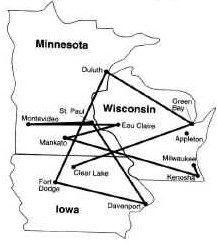
Bookings for the Winter Dance Party were:
January 23 - George Devine's Ballroom, Milwaukee, Wisconsin
January 24, Eagles Ballroom, Kenosha, Wisconsin
January 25, Kato Ballroom, Mankato, Minnesota
January 26, Fournier's Ballroom, Eau Claire, Wisconsin
January 27, Fiesta Ballroom, Montevideo, Minnesota
January 28, Promenade Ballroom, St. Paul, Minnesota
January 29, Capitol Theater, Davenport, Iowa
January 30, Laramar Ballroom, Fort Dodge, Iowa
January 31, Duluth Armory, Duluth, Minnesota
February 1, Riverside Ballroom, Green Bay, Wisconsin
February 2, Surf Ballroom, Clear Lake, Iowa
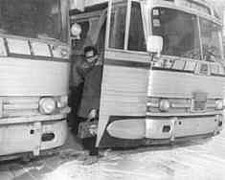 "The Winter Dance Party" proved to be a nightmare for the entourage, traveling in winter weather several degrees below zero
and crammed into a drafty bus with a failing heating system that eventually broke down completely. By the first of February, Carl Bunch, Buddy Holly's drummer, left the tour, a victim of severe frost-bitten feet. The tour was scheduled to play two shows that
day, then travel on to Clear Lake
for the next evening's performance at the Surf Ballroom.
"The Winter Dance Party" proved to be a nightmare for the entourage, traveling in winter weather several degrees below zero
and crammed into a drafty bus with a failing heating system that eventually broke down completely. By the first of February, Carl Bunch, Buddy Holly's drummer, left the tour, a victim of severe frost-bitten feet. The tour was scheduled to play two shows that
day, then travel on to Clear Lake
for the next evening's performance at the Surf Ballroom.
By the time the bus pulled into Clear Lake, the group found
themselves in a foul mood. Holly told his remaining band members, guitarist Tommy Allsup and bassist Waylon Jennings,
that after the concert he would charter a plane from Dwyer's Flying Service out of Mason City to fly them on to
Fargo, North Dakota where the airport served the twin cities of Fargo and Moorhead, Minnesota, arriving ahead of the rest of the group.
The group had been traveling for over a week in a cramped cold bus. They were tired and
they hadn't been paid yet. Besides, they needed to get their laundry done.
Admission to The Surf's "The Winter Dance Party" was $1.25. The concert was magical as fans went wild over the
performers. During each break, the band members met with the kids. The last song of the night was The Big Bopper's "Chantilly Lace."
Carroll Anderson, manager of the Surf, chartered a four-seat Beechcraft Bonanza for Holly, Jennings and Allsup at $36 per person. Richardson and Valens talked Jennings and Allsup out of their seats. [According to legend, there was a coin-toss between Allsup and Valens for a seat on the plane.
Valens allegedly exclaimed, "That's the first time I've won anything in my life!" This coin toss legend,
however, has been hotly contested.] It has been said that Richardson was suffering from the flu and running a fever.
It has also been said
that Ritchie was coming down with a cold.
Holly and Jennings teased one another about the situation. According to legend, Holly told Jennings that he hoped the bus froze up. Jennings retorted, saying that he hoped the plane crashed. It has been
said that Jennings' flippant comment would haunt him the rest of his life.
 Immediately after the concert, Buddy called his wife, Maria Elena, and Ritchie called his brother, Robert Morales. Then
the manager of the Surf Ballroom, along with his wife and eight-year-old son, gave Holly, Richardson and Valens a ride to the Mason City
airport.
However when they arrived, H. "Jerry" Dwyer wasn't there. The musicians were at wit's end as to how to continue their tour.
Roger Peterson, a 21-year-old pilot who worked for Dwyer, agreed to fly them to Fargo. Although Peterson was fatigued after
working a 17-hour day, he didn't think there would be any problem. Snow blew across the runway but the sky was clear. Peterson checked in with the Air Communications Station several times prior to departure, checking on the weather conditions.
The musicians packed their instruments and made final flight arrangements.
Immediately after the concert, Buddy called his wife, Maria Elena, and Ritchie called his brother, Robert Morales. Then
the manager of the Surf Ballroom, along with his wife and eight-year-old son, gave Holly, Richardson and Valens a ride to the Mason City
airport.
However when they arrived, H. "Jerry" Dwyer wasn't there. The musicians were at wit's end as to how to continue their tour.
Roger Peterson, a 21-year-old pilot who worked for Dwyer, agreed to fly them to Fargo. Although Peterson was fatigued after
working a 17-hour day, he didn't think there would be any problem. Snow blew across the runway but the sky was clear. Peterson checked in with the Air Communications Station several times prior to departure, checking on the weather conditions.
The musicians packed their instruments and made final flight arrangements.
At 11:30 p.m., Peterson was told that the
ceilings and visibility were still good but there was a change in the arrival of the cold front. Twenty-five minutes later,
at 11:55, Peterson obtained the latest information from the Air Communications Station, stating that the weather had
changed with the ceiling lowering 1000 feet with winds picking up and light snow beginning to fall.
Peterson started the engine of the single-engine Beechcraft Bonanza and received clearance
from the control tower. He taxied down the runway and took off at 12:55 a.m., February 3rd. Peterson told the control tower that he would file
his flight plan to Fargo once he was airborne.
According to legend, by the time Peterson was taxing down the runway, DWYER had returned and noticed that the take-off was shaky.
The plane stayed in air for only a few minutes. Air Traffic Control lost radio contact within five minutes after the
Beechcraft took off. No one is completely sure what went wrong. A Civil Aeronautics Board report stated that
upon flying into bad weather with snow and gusting wind, Peterson experienced a lethal combination of spatial disorientation and misinterpreting
an instrument [IRF - instrument flight rules when weather conditions are below the minimum for visual
flight rules], and flew the plane down into the ground instead of up into the air. The report states that the probable cause of the accident was "the pilot's unwise decision to embark on a flight which would necessitate flying
solely by instruments when he was not properly certificated or qualified to do so. Contributing factors were serious
deficiencies in the weather briefing and the pilot's unfamiliarity with the instrument which determines the attitude of
the aircraft." With only a sea of white snow and white below, Peterson thought he was ascending into the air.
The final report by the Civil Aeronautics Board noted that Peterson had taken his instrument training on airplanes
that were equipped with an artificial horizon attitude indicator instead of the less common Sperry Attitude
Gyro that was on the Beechcraft Bonanza. The two instruments display the aircraft's pitch attitude in the exact opposite
manner which would have caused Peterson to believe he was ascending when in actuality he was descending. The Board also
concluded that Peterson was not given adequate weather condition warnings with regard to his route. Given Peterson's
limitations, he probably would have postponed the flight had he received adequate warnings.
One wing hit the ground and the plane plowed at 170 mph into a cornfield, flipping over on itself and tossing the passengers into
the air. Peterson's body remained wedged inside the airplane.
At 3:30 a.m. the Fargo control tower alerted the Mason City airport that the flight had never arrived. Worried but detained
until the fog had lifted, Dwyer
departed in his own plane at 9:15 a.m. to search for the Beechcraft. He found it five miles northwest of the airport
near Clear Lake, crashed into a cornfield with bodies strewn about the site.
Due to the weather, no one could reach the crash site until later that morning. The bodies laid where they landed for
ten hours as snowdrifts formed around them.
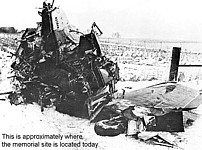 MASON CITY, Ia. -- Feb. 3 (AP) Three of the country's top rock 'n' roll idols, whose records and appearances
stirred millions of teenagers, were killed early yesterday in a cold, snow-swept Iowa field. The four-place
chartered airplane carrying the trio and their pilot crashed within minutes after taking off in light snow from
the Mason City airport.
MASON CITY, Ia. -- Feb. 3 (AP) Three of the country's top rock 'n' roll idols, whose records and appearances
stirred millions of teenagers, were killed early yesterday in a cold, snow-swept Iowa field. The four-place
chartered airplane carrying the trio and their pilot crashed within minutes after taking off in light snow from
the Mason City airport. Killed were Ritchie
Valens, 17 of Los Angeles, Buddy Holly, 22, of Lubbock, Tex., and J. P. Richardson Jr., of Beaumont, Tex. [some
accounts of the day gave New Orleans], known professionally as "Big Bopper" and Roger Peterson, 21, of
Clear Lake, Iowa, the pilot. The troupe which which the trio had appeared had entertained an estimated
1,000 teenagers and their parents at the Surf Ballroom in nearby Clear Lake Monday night.
Charted PlaneThe Beachcraft Bonanza chartered from the Dwyer Flying Service of
Mason City, was to take the three singers to Fargo, N.D., in advance of the troupe's engagment there.
The others went in a chartered bus. Holly, Richardson and Valens, [illegible] popularity among the teenaged
rock 'n' roll set in the past several years, chartered the plane in order to take care of advance
arrangments. Authorities initially blamed weather conditions for the crash. Besides the snow, the
temperature was 13-degrees and a southerly wind was gusting at 35 miles per hour. The left wingtip
apparently struck the ground first and flew off. Pieces of the wreckage ripped of as the plane plowed
about two city blocks distance across the field and piled up against a wire fence. Badly
Burned
 The plane came down about five miles northwest of the airport on the Albert Juhl farm.
Apparently no one heard the crash. NOTE: The Juhl house was located approximate a 1/8
mile from the crash site. ~ SRB
The plane came down about five miles northwest of the airport on the Albert Juhl farm.
Apparently no one heard the crash. NOTE: The Juhl house was located approximate a 1/8
mile from the crash site. ~ SRB Three of the badly burned bodies were lying on the ground near
the wreckage and one remained in the wreckage. Mrs. Carroll Anderson, whose husband manages the Surf
Ballroom, said "everything sounded okay when the plane took off." Hollywood trade securities and
the combined record sales of the three rock 'n' rollers was in the millions.
The Headlines
Nationally Known Rock 'n' Rollers, Lake Man Victims
British Daily News, TOP 'ROCK' STARS DIE IN CRASH
February 3, 1959, page 66
IOWA AIR CRASH KILLS 3 SINGERS
_____________
Rock 'n' Roll Stars and Pilot
Die
as Chartered Craft Falls After Its Take-off
Former Mason City Globe Gazette photographer Elwin Musser holds the photograph he took February 3, 1959,
at the site of the plane crash north of Clear Lake.Elwin Musser carried his camera to a farm field north
of Clear Lake, having no idea it would be one of Iowa's most notorious day. "The leg wing of the
Beechcraft Bonanza hit here," he said, pointing to the spot. "The fuselage dug in next and the plane
skidded 570 feet and crumpled into a heap by a fence." Musser, who had taken hundreds of accident
photographs in his career, lifted his camera. Steadily, he began taking photographs. Fifty years later
Musser softly said, "I see the fence posts have changed."
Crash Site Photographs
Click on link to see photograph;
click back button to return to this webpage.
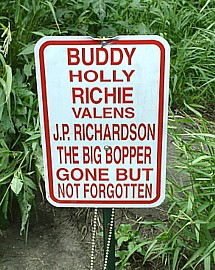

Crash Scene Photograph
Crash Scene Photograph
Crash Scene Photograph
Crash Scene Photograph
Crash Scene Photograph
Crash Scene Photograph
Crash Scene Photograph
Big Bopper's Luggage
Crash Scene Photograph
Years later, Dion DiMucci said, "I didn't even have a coin to flip for a seat on the airplane, Besides, at
the time $36 for the flight seemed like a waste of money. We had the bus. I was only 19-years-old."
DiMucci said that when he heard about the accident the next day, they were already at Fargo. "I was totally,
like, in shock. I walked back out to the bus, and I was the only one on the bus. Ritchie's blue outfit was
hangin' from the luggage rack, and Buddy's guitar was on the seat. I was alone on the bus. And I was baffled."
It has been said that if everyone who claimed that they were at the Surf Ballroom that night actully HAD
been there, the crowd would have reached 50,000. The Surf holds about 2,000 people. A more realistic estimate
is that the actual count was close to 1,500 attending the concert.
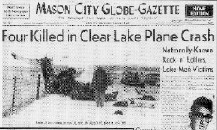
Frankie Sardo and Dion & The Belmonts continued until the end of the tour.
Bobby Vee & The Shadows performed on the February 3rd date at Moorhead.
Jimmy Clanton, Fabian and Frankie Avalon were substituted as headliners.
The Crickets finished the tour with Ronnie Smith as lead vocalist.
The remainder of the Winter Dance Party tour was:
February 3 - Moorhead, MN - The Armory
February 4 - Sioux City, IA
February 5 - Des Moines, IA - Val Air Ballroom
February 6 - Cedar Rapids, IA - Danceland Ballroom
February 7 - Spring Valley, IL - Les Buzz Ballroom
February 8 - Chicago, IL - Aragon Ballroom
February 9 - Waterloo, IA - Hippodrome Auditorium
February 10 - Dubuque, IA - Melody Hill
February 11 - Louisville, KY - Memorial Auditorium
February 12 - Canton, Ohio - Memorial Auditorium
February 13 - Youngstown, Ohio - Stanbaugh Auditorium
February 14 - Peoria, IL - The Armory
February 15 - Springfield, IL - Illinois State Armory
Roger Peterson's funeral was held on Friday, February 6th at his hometown of Alta, Iowa, with interment at
Buena Vista Memorial Park Cemetery.
J. P. "The Big Bopper" Richardson's funeral was held on Friday, February 6th at Broussard's Funeral Home in
Beaumont, Texas. Private Elvis Presley and Colonel Tom Parker sent yellow roses to his funeral. Richardson was
buried in Forest Lawn Memorial Park, Beaumont, Texas.
Buddy Holly's funeral was held at the Tabernacle Baptist Church in Lubbock, Texas, on February 7th, drawing over a thousand
mourners. His widow, however, did not attend the services nor has she ever visited Buddy's gravesite. He was interred in
the City of Lubbock Cemetery, located in the eastern part of the city.
Ritchie Valen' funeral was held at Nobel Chapel Funeral Home in San Fernando Valley, on February 7th. He was driven to
San Fernando Mission Cemetery in a copper-colored hearse and buried in San Fernando Mission Cemetery, California.
J. P. "The Big Bopper" Richardson's son, Jay Perry, was born in April of 1959, two months after his father's death.
Richardson had written
20 new songs which he intended to record himself or with other artists. In January of 2007, son Jay requested that J. P.'s
body be exhumed and autopsied to settle rumors that a gun had been fired during the flight and that Richardson initially survived the plane
crash. [Rumors that Richardson had initially survived the crash were fueled by the fact that his body was located quite a
distance from the crashed aircraft. The gunfire rumor arose from the pistol authorities found among the wreckage.] When the casket was opened, Dr. Bill Bass, a forensic anthropologist with the University of Tennessee at Knoxville,
and Jay, who was present for the autopsy, were amazed to find Richardson's remains to be very well preserved. The autopsy
revealed that Richardson sustained massive skull fractures and fractures from head to toe, dying immediately. There were no indications of
foul play.
Beaumont Enterprise, Beaumont, Texas
by Ron Franscell
'Big Bopper's' son auctioning Dad's casket
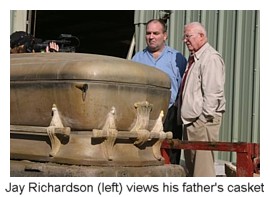 The Big Bopper's 16-gauge steel casket was exhumed last year from his original grave at Forest Lawn Cemetery in Beaumont,
Texas, so it could be moved to a more visible location with a life-size statue and historic marker. The disinterment also
offered forensic experts a chance – with his family's blessing – to examine the pop singer's unautopsied remains after
his death in rock 'n' roll's first great tragedy.
The Big Bopper's 16-gauge steel casket was exhumed last year from his original grave at Forest Lawn Cemetery in Beaumont,
Texas, so it could be moved to a more visible location with a life-size statue and historic marker. The disinterment also
offered forensic experts a chance – with his family's blessing – to examine the pop singer's unautopsied remains after
his death in rock 'n' roll's first great tragedy.
On Feb. 3, 1959, Richardson died at age 28 in the crash of a small plane in a field near Clear Lake, Iowa, that also
killed 1950's rock stars Buddy Holly and Ritchie Valens and sent a shock wave around the world. The accident was
immortalized as "the day the music died" in American Pie, an early-1970's hit song by Don McLean.
Richardson was buried a few days later in his Beaumont hometown with great fanfare, including tributes from Elvis Presley
and others.
Jay Richardson, the Bopper's son, plans to sell the empty casket on eBay to raise money for a musical show
about his father and to keep the Bopper's memory alive. Born three months after the crash, Jay, who lives in Katy, Texas,
never met his father in life – but saw him for the first time at his exhumation.
"Wouldn't it be wonderful to bring Dad back to life?" Jay, 49, said recently from Canada, where he was touring with a
tribute act to his father, Holly and Valens.
"I have no personal use for the casket, he said. "When you get down to it, it is just a metal box. . . . Even though it
was Dad's resting place for 48 years, it's also a unique opportunity to learn more about the early years of rock 'n'
roll."
The exhumed casket is in surprisingly good condition after 48 years in the muddy gumbo of Southeast Texas. It bears minor
rust spots and a white lime stain showing where several inches of water once leaked into the surrounding vault, but there
was no evidence water had ever seeped into the casket itself.
Inside, forensic examiners found the Big Bopper's well-preserved corpse, dressed in a black suit and a blue-and-gray
striped tie. He wore socks, but no shoes. Most remarkably, his thick brown hair was still perfectly coiffed in his
familiar, 1950's flat-top.
After the 2007 autopsy found he died of crash-related injuries, the Big Bopper was reburied in a sleek new [sapphire blue] casket donated
by the Batesville Casket Co., which made the original. Since late last year, the old casket has been on public display at
the Texas Musicians Museum in Hillsboro, Texas.
The Big Bopper died right as he was hitting the big time. The happy-go-lucky Texas DJ in a leopard-skin jacket would sell
a million records but never see a dime from his greatest hit, Chantilly Lace. He also wrote the George Jones hit,
White Lightning. Tom Kreason, the Texas Musicians Museum's founder, admits the casket is macabre but says it is a
"priceless" artifact of a historic moment in music. He approached some auction houses about selling the casket, but "they
all seemed confused,” so he decided to reach for a wider audience on eBay. The Texas Musicians Museum will receive an
undisclosed share of the sale, he said.
How much could a used celebrity casket bring on the open market? A handful of memorabilia dealers shied away from
guessing, largely because a used celebrity casket has never been offered for sale.
"Certainly there'll be some distaste, but I think this is a piece of history that is very special," Kreasib said.
"Even if it doesn't sell, we've made a point about the historical value of J. P. Richardson. No matter what happens, he
wins, historically."
NOTE: After much protest, the Big Bopper's casket did NOT go on sale at eBay or any other auction house. It still remains in display at the Texas Musicians Museum.
The Globe Gazette
Mason City, Cerro Gordo County, Iowa
Thursday, October 13, 2001
by Peggy Senzarino
Bopper Jr. makes donation to the Surf
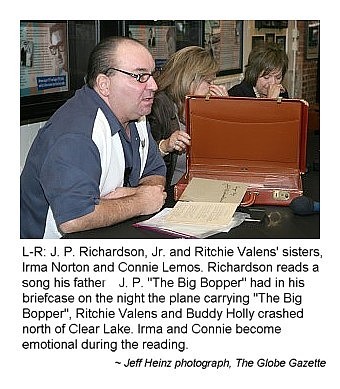 CLEAR LAKE — A briefcase belonging to J. P. "The Big Bopper" Richardson has been loaned to the Surf Ballroom & Museum for
display at the Clear Lake landmark.
The donation was made as part of Thursday's celebration and dedication of the new Three Stars Plaza near the Surf
Ballroom and the neon central art feature.
CLEAR LAKE — A briefcase belonging to J. P. "The Big Bopper" Richardson has been loaned to the Surf Ballroom & Museum for
display at the Clear Lake landmark.
The donation was made as part of Thursday's celebration and dedication of the new Three Stars Plaza near the Surf
Ballroom and the neon central art feature.
The event also included the re-dedication of Buddy Holly Place and honorary dedication of Ritchie Valens Drive (North
Shore Drive) and J. P. Richardson Avenue (7th Avenue North).
Richardson's son, J. P. Richarson Jr., along with Ritchie's sisters Connie Lemos and Irma Noton were in Clear Lake for
the ceremony.
Maria Elena Holly, widow of Buddy Holly, was ill and unable to make the trip, according to Surf Ballroom executive
director Laurie Lietz.
The briefcase survived the Feb. 3, 1959, plane crash in Clear Lake which killed The Big Bopper, Buddy Holly, Ritchie Valens and pilot Roger Peterson.
"A lot more people are going to see it here than in the closet at my house. And so any way, this briefcase survived
the plane crash. It has dad's initials on the front of it," Jay Richardson said.
A notebook filled with songs The Big Bopper was working on at the time of his death was found inside the briefcase.
Richardson also donated a notebook filled with songs his father wrote as a boy.
The memorabilia also included a hotel receipt for $3.75 from Ironwood, Mich., for the night of Feb. 1, 1959.
"I tell people, you know my dad's hometown that he was so proud of, has zero memorials in his honor. And a town of 8,000 people where he spent eight hours maybe in his entire life has done the things that you all have done for him," Richardson said.
Ritchie's sister Irma Norton thanked the community for remembering her brother, The Big Bopper and Buddy Holly.
"We have our times that we cry but we know that you guys loved our Ritchie and our other two little stars," Norton
said.
Connie Lemos said this is a continuation of the family's love affair with the Surf.
 "You walk in here and it's like, Wow," Lemos said.
"It's a homecoming. It is a reunion. Everything they do here at the Surf is done with so much care and so much love."
"You walk in here and it's like, Wow," Lemos said.
"It's a homecoming. It is a reunion. Everything they do here at the Surf is done with so much care and so much love."
A crowd of about 75 people gathered for the ceremony Thursday evening.
Jeff Nicholas, president of the Surf Ballroom, unveiled the central art feature which now graces the plaza about a
half block from the Surf.
The art feature has a central column that resembles a record spindle with three records stacked on top.
The bottom record has the names of the performers inscribed on it. It is illuminated in the same blue neon that
encircles the plaza and the sides of the spindle.
The art feature was paid for by Steve and Vickie Sukup of Clear Lake.
The pedestal is 24 inches in diameter and made of one-quarter-inch steel pipe. It is 15 feet high and weighs 1,600
pounds.
The Big Bopper was inducted into the Rockabilly Hall of Fame in 1997; the Texas Country Hall of Fame in
2004; and, the Texas Radio Hall of Fame in 2008. His son, Jay, took up a musical career and is known professionally
as "The Big Bopper, Jr." performing all around the world and with the "Winter Dance Party", appearing on some of the
same stages where his father performed.
Ritchie Valens, only seventeen-years-old when he died, leaving a legacy of only two popular records - "Donna" and "La Bamba"
which gave inspiration for Los Lobos, Freddy Fender, The Midnighters, Trini Lopez, and Sunny and the Sunglows, The Rascals,
Bob Dylan, and R.E.M. "La Bamba" was the model for the Isley Brothers' 1961 hit "Twist and Shout." He was the inspiration
for many of the garage bands of the early 1960's. The successful movie "La Bamba" based on Ritchie's life was released
in 1987. Ritchie received a star on Hollywood's Walk of Fame in 1990 and was inducted into the Rock and Roll Hall of
Fame in 2001.
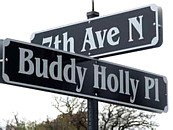 Dion DiMucci was inducted into the Rock and Roll Hall of Fame in 1989.
Dion DiMucci was inducted into the Rock and Roll Hall of Fame in 1989.
Maria Elena Holly was pregnant at the time of the crash and tragically suffered a miscarriage. She was instrumental in
establishing the Buddy Holly Center in Lubbock, Texas.
Buddy Holly was one of the two great singer-songwriter guitarists of the 1950's (the other one being Chuck Berry). Holly was probably the first rock and roll artist to concern himself with virtually every aspect of his music, including arranging
and record production. Holly was inducted into the Rock and Roll Hall of Fame in 1986. He is also recognized
in the Rockabilly Hall of Fame. A street flanking the Surf Ballroom's east property line is named Buddy Holly Place in his honor.
Afterward
During the 1950's and 1960's artists such as Link Wray,
Sam the Sham, The Everly Brothers, Jan and Dean, The Beachboys, Bobby Rydell, Waylon Jennings, and
Conway Twitty took the stage at the Surf. During the early 1970's,
Santana, REO Speedwagon, and Kansas made their appearances on the now famous stage.
Darrel Hein assumed management of the Surf in 1975, then later it was managed by Bruce Christensen. The Snyder family
obtained ownership of the Surf during the 1990's and did significant renovation.
The Winter Dance Party Continues On
The Surf Ballroom's "Winter Dance Party" annual event
began as an on-air jest made by Clear Lake radio personality "The Mad Hatter" during a broadcast late in the 1970's on
Clear Lake's local radio station KZEV.
"The Mad Hatter" (a.k.a. Darryl Hensley) said during his program, "There is a
time warp in my studio and Buddy Holly has just walked in."
Hensley proceeded to pretend that he was having an on-air
conversation with Holly. During this conversation 'Buddy' suggested the idea of holding a memorial concert at the
Surf on the 20th anniversary of his death. Hensley said he would make it happen.
One would like to say the 'rest
was history' however making the event happen proved to be quite challenging. Six weeks prior to the concert the original
slate of entertainers cancelled. Hensley turned to fellow disc jockey Wolfman Jack for assistance and also serve as
master of ceremonies. Included in the concert line-up were Del Shannon, the Drifters, Jimmy Clanton, The Whitesidewalls,
and original Cricket band member Nikki Sullivan. Hensley turned it into a media event by giving away hundreds of tickets
to media sources across the country.
The first memorial concert called "The Tribute to Buddy Holly Concert" was held
on Saturday, February 3, 1979. The original concert lost $4,000 but it didn't take long for it to become an annual
event that sustains itself and carve a niche into rock and roll history.
By the mid-1980's, the Surf sponsored some
'warm-up activities' on Thursday nights. These activities were officially incorporated into the annual 'tribute weekend',
becoming a 3-day event with a sock-hop on Friday night and the six-plus hour concert on Saturday night. Currently, the event has
been expanded to include a Wednesday night concert, turning Clear Lake into a Mecca during the first few days of February.
In 1999 the Clear Lake Area Chamber of Commerce presented The Mad Hatter Darryl Hensley with a plaque which said, "In
recognition and appreciation of your bold and visionary efforts from conception to production of the first annual
Buddy Holly Tribute. Because of your efforts, the music will never die."

This Day In History, February 29, 1980
Buddy Holly's Glasses, Lost Since His Death in 1959,
Are Found in Mason City, Iowa
When the Beechcraft Bonanza carrying Buddy Holly, Ritchie Valens
and the Big Bopper crashed outside Clear Lake, Iowa, in the early morning hours of February 3, 1959, it struck the ground
with such force that all three passengers [and the pilot] were killed instantly, and the plane's wreckage was strewn across nearly 300
yards of snow-covered cornfields. The death certificate issued by the Cerro Gordo County Coroner noted the clothing Holly
was wearing, the presence of a leather suitcase near his body and the following personal effects:
Charles Holly
Cash $193.00 less $11.65 coroner's fees - $181.35
2 Cuff links, silver 1/2 in. balls having jeweled band
Top portion of ball point pen
Notably missing from the list were Holly's signature eyeglasses, the most distinctive visual legacy of a man who
influenced the sound and style of rock and roll immeasurably. Those famous glasses were presumed lost forever until the
announcement on February 29, 1980, that they had resurfaced in Mason City, Iowa.
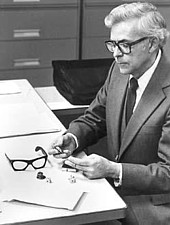 The glasses in question had the appearance of something government issued, but they were, in fact, carefully chosen as
part of Holly's image — not by Holly himself, but by his Lubbock, Texas, optometrist, Dr. J. Davis Armistead.
The glasses in question had the appearance of something government issued, but they were, in fact, carefully chosen as
part of Holly's image — not by Holly himself, but by his Lubbock, Texas, optometrist, Dr. J. Davis Armistead.
"Buddy was
trying to wear the least conspicuous frames he could find," wrote Dr. Armistead nearly 40 years after writing Holly's
last prescription. "Personally, I was not happy with the frame styles we had been using. I did not think they contributed
anything to a distinct personality that a performer needs."
It was while on vacation in Mexico City that Armistead found
exactly the frames that he felt Holly needed. He brought back two pairs of the heavy plastic Faiosa frames.
"Those heavy
black frames achieved exactly what we wanted — they became a distinct part of him."
In fact, they became a part of the basic
iconography and spirit of rock and roll. Before Buddy Holly, it would have been impossible to imagine a skinny, knock-kneed
kid in an Ivy League suit and thick, heavy glasses being considered "cool." After Buddy Holly, the look and attitude
that would later be called "geek chic" became a completely accepted alternative style for an aspiring rock star to embrace.
So how did the famous glasses re-emerge?
In the violence of the crash back in February 1959, they were thrown clear of
the other wreckage and buried in the snow. They were found, along with the Big Bopper's watch, that same spring when the
melting snow made them visible again. Although they were handed in immediately to the Cerro Gordo County Sherriff's office,
they sat filed away for the next 21 years in a sealed manila envelope marked "rec'd April 7, 1959."
That envelope was
opened by Sheriff Jerry Allen on this day in 1980. The glasses were eventually returned to Holly's widow, and can now
be seen in the exhibit at the Buddy Holly Center in Lubbock, Texas.
Paying Tribute
Once it was just another Iowa field, much like all the other
farmland surrounding it. Then, after February 3, 1959, this field became hallowed ground to fans and music lovers alike.
However people who visited the crash site didn't know exactly where it was located. Flowers and tributes were scattered
all long the fence line located on private land.
Ken Paquette, a 50's era fan who lived in Portersfield, Wisconsin,
fifty miles north of Green Bay, said, "I thought there should be something there."
In 1988, Paquette made a stainless
steel guitar and a set of three stainless steel records. On the guitar he etched out the names of Buddy Holly,
Ritchie Valens, and the Big Bopper along with the date of the crash "2/3/59." He etched out on the three records
the names of the recording labels and the artists' biggest hits: "Peggy Sue" on Coral, "Donna" on Del-Fi, and
"Chantilly Lace" on Mercury.
Paquette created a similar steel monument which is located outside of the Riverside
Ballroom in Green Bay, where the artists played on the night of February 1, 1959. This memorial was unveiled on
July 17, 2003.
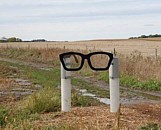 The crash site is located on private farmland, approximately
one-quarter of a mile west of the intersection of 315th Street and Gull Avenue, five miles north of Clear Lake. In
1999, four trees were planted along the fence row, one for each performer and the pilot.
At the access point to the crash site there is a post-sign of horn-rimmed glasses.
The crash site is located on private farmland, approximately
one-quarter of a mile west of the intersection of 315th Street and Gull Avenue, five miles north of Clear Lake. In
1999, four trees were planted along the fence row, one for each performer and the pilot.
At the access point to the crash site there is a post-sign of horn-rimmed glasses.
REMEMBER: The crash site is
located on private property. Please respect the property owners' rights when visiting the site. Thank you!
The Des Moines Register
Des Moines, Iowa
February 2, 2009
Memorial to Buddy Holly Pilot
Dedicated at Crash Site
 Clear Lake, Ia. — Ken Paquette planted a steel monument
to pilot Roger Peterson today in a frozen Iowa corn field.
Clear Lake, Ia. — Ken Paquette planted a steel monument
to pilot Roger Peterson today in a frozen Iowa corn field.
Friends and fans gathered to dedicate a memorial to Peterson at the site of his plane crash 50 years ago.
Peterson has largely been ignored because of the fame of his passengers in 1959. Buddy Holly, J. P. "Big Bopper" Richardson and Ritchie Valens have received many tributes since their final flight.
Paquette, a welder from Porterfield, Wis., crafted a steel memorial to the stars 21 years ago. He worked for several
weeks to craft a pilot wings-shaped monument for Peterson.
"I've been thinking about it for a long time," said Paquette, who shivered with a handful of spectators amid corn
stubble. "It should have been done sooner."
Paquette created a steel monument for the musicians in 1988. A guitar and thee record albums displayed their names.
Part of the monument was stolen and later replaced.
On Monday afternoon, Peterson's name joined those of his passengers.
"There were four men killed, not one, two or three," said Jerry Dwyer, who owned the plane that was destroyed in the
crash. "He was one fine young man."
Peterson was 21 years old at the time of the crash.
Fans from England, New York and California were among those who gathered for Monday's tribute.
NOTE: Ken Paquette crafted the Peterson memorial and offered the piece at no cost. Peterson's former boss, Jerry Dwyer and his wife, Barb, unveiled the metal memorial shaped like a pair of
wings.

The Clear Lake Mirror Reporter
Clear Lake, Iowa, January 16, 2008
Surf Ballroom Reopens
Helping Preserve The Surf for Generations to Come
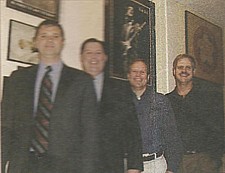 The North Iowa Cultural Center and Museum, Inc. has been
formed for the purpose of preserving, maintaining and managing the historic Surf Ballroom property as a center for
cultural and civil purposes in the greater North Iowa area. The group, comprised at this time by Shane Cooney and Paul
Stevenson (left) and Jeff Nichols (right) announced it will lease the Surf Ballroom from the Snyder
family and re-open
the ballroom Jan. 25. Pictured with the non-profit board members is Dale Snyder.
The North Iowa Cultural Center and Museum, Inc. has been
formed for the purpose of preserving, maintaining and managing the historic Surf Ballroom property as a center for
cultural and civil purposes in the greater North Iowa area. The group, comprised at this time by Shane Cooney and Paul
Stevenson (left) and Jeff Nichols (right) announced it will lease the Surf Ballroom from the Snyder
family and re-open
the ballroom Jan. 25. Pictured with the non-profit board members is Dale Snyder.
Volunteer Board of Directors
Apply for Non-profit Status
The Dean Snyder family of Clear Lake announced Tuesday that they have entered into a lease agreement with a business
called the North Iowa Cultural Center and Museum, Inc. Their intention is to operate the Surf Ballroom as a non-profit
organization.
The Snyder family purchased the Surf Ballroom in 1994 with the intention to preserve the ballroom for all
of North Iowa.
"It was never our desire to operate the business ourselves," said Dale Snyder. "It has been both a privilege
and a challenge to own the Surf. We have, over these years, learned many things. Quite frankly, some good and some not so
good. Unfortunately, the overriding lesson learned is that operating the Surf at a profit is an increasing challenge."
The North Iowa Cultural Center and Museum, Inc. is comprised of a group of volunteers organizing for the purpose of
preserving, maintaining and managing the historic Surf Ballroom property as a center for cultural and civic purposes
in the great North Iowa area.
"We envision a number of specific benefits to this community, the county and all of
North Iowa," commented Jeff Nichols, board member of the North Iowa Cultural Center and Museum. "In addition to ensuring the
future of such signature events as the Winter Dance Party and appearances by renowned artists, we believe that the Surf
Ballroom and Museum can truly be an important stop for all out-of-town visitors. We want to showcase and explain the
invaluable pictures, posters and memorabilia within the building, make greater use of the Surfside 6 Lounge, and make the
facility more available for 'off-peak' times for community meetings and private functions."
The corporation will work to
preserve the physical structure and character of the historic Surf Ballroom, making the facility available to a wide variety
of civic, non-profit and other groups for meetings, functions and events. The non-profit status of the corporation will
allow the solicitation of contributions and should make it an attractive grant applicant.
"Everyone involved with this
project has a passion for the Surf Ballroom and a desire to see the ballroom doors remain open," said Board Member Paul
Stevenson. "We understand the significant impact the Surf plays on tourism and steps needed to be taken to ensure its
future. We believe this is an important endeavor for Clear Lake and all of North Iowa."
The three men say they envision
eventually expanding the North Iowa Cultural Center and Museum board to nine to 11 members. In addition, an executive
director will be hire to promote the musuem aspect of the Surf Ballroom to potential visitors, including bus tours.
"We consider tourism built upon the museum side of the Surf to be a large component of the financial stability of the
Surf," said Nichols.
The executive director position has been advertised and has drawn applicants locally, as well as
from throughout the country. The person chosen for the position could be named within the next few weeks or a month,
said board members.
A lease agreement with CDGB's, operated by Kevin Schonemann, expired on Dec. 31, 20007. Schonemann had managed the Surf for the past five years.
NICHOLAS said he and other board members talked with Dale Snyder after he received
word Schonemann would not renew his lease.
"We made a commitment to him that we were here to help maintain the history of
the Surf Ballroom," Nicholas said.
Globe Gazette
Mason City, Cerro Gordo County, Iowa
Thursday, September 8, 2011
Holly gets his Hollywood star
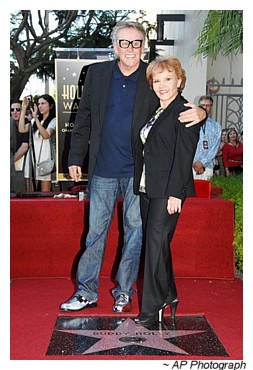 LOS ANGELES — Buddy Holly got his star on Hollywood's Walk of Fame Wednesday on what would have been his 75th birthday.
LOS ANGELES — Buddy Holly got his star on Hollywood's Walk of Fame Wednesday on what would have been his 75th birthday.
His widow, Maria Elena, helped unveil the star outside of the Capitol Records Building, according to various media
outlets. Also on hand were actor Gary Busey, who played Holly in the movie, "The Buddy Holly Story," as well as singers Phil
Everly and producer Peter Asher.
Holly was killed in 1959 in a plane crash after his last performance at the Surf Ballroom in Clear Lake. Also killed were
Ritchie Valens and J. P. "The Big Bopper" Richardson with the pilot, Roger Peterson.
The Surf Ballroom & Museum has various displays on the artists and their impact on music and is a major North Iowa
attraction. Also, hundreds of people visit the crash site yearly. It is located just north of Clear Lake.
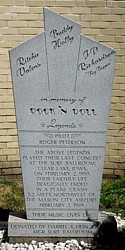 Many items are housed in the Surf's museum, such as: a set of headphones
from the airplane that carried Buddy Holly, Ritchie Valens, J. P. "The Big Bopper" Richardson, and pilot Roger
Peterson; a poster advertising the February 1959 Winter Dance Party; an Authentic Gibson Limited Edition Buddy Holly model
guitar presented to the Surf by the Gibson Guitar Company; and photographs - lots of photographs and posters.
Many items are housed in the Surf's museum, such as: a set of headphones
from the airplane that carried Buddy Holly, Ritchie Valens, J. P. "The Big Bopper" Richardson, and pilot Roger
Peterson; a poster advertising the February 1959 Winter Dance Party; an Authentic Gibson Limited Edition Buddy Holly model
guitar presented to the Surf by the Gibson Guitar Company; and photographs - lots of photographs and posters.
The Rock and Roll Hall of Fame and Museum, located in Cleveland,
Ohio, dedicated the Surf Ballroom as a historic rock and roll landmark, identifying it as a location in America that
is significant to the origins and the development of rock and roll music. The plaque reads: There are few buildings
in existence today that represent a complete shift in our musical history. As the last concert venue for Buddy Holly,
Ritchie Valens and J. P. "The Big Bopper" Richardson, the Surf is the bedrock of where the sound and attitude of
rock and roll changed forever."
Currently Scott Anderson manages the Surf Ballroom. The exterior and the neighborhood around the Surf has changed
very little since the 1950's.
The Surf is alive and doing well, as this writer can personally
attest, having enjoyed B. B. King's performance there during his farewell tour.
Rock on, Surf, rock on.
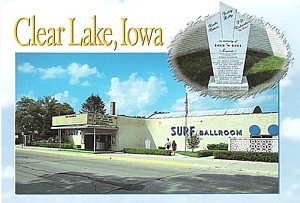 SOURCES:
SOURCES:
http://www.surfballroom.com/surf_history.html
http://www.surfballroom.com/WDPHistory.html
http://en.wikipedia.org/wiki/Surf_Ballroom
http://www.iowaballroom.com/p/act/surf/surf.html
http://www.history-of-rock.com/winter_dance_party.htm
http://www.history-of-rock.com/buddy_holly.htm
http://en.wikipedia.org/wiki/The_Big_Bopper
http://www.history-of-rock.com/ritchie_valens.htm
http://www.history.com/this-day-in-history/buddy-holly39s-glasses-found
articles from The Clear Lake Mirror Reporter and The Des Moines Register
Compilation & portions written by Sharon R. Becker, January of 2011;
updated October of 2011
Crash memorial site & Surf memorial photographs by Sharon R. Becker
Lyrics to Don McLean's American Pie
|